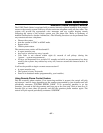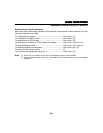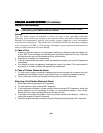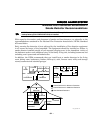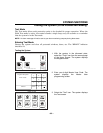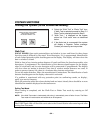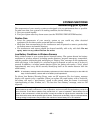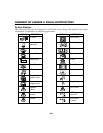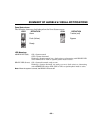
– 65 –
SYSTEM FUNCTIONS
Maintaining your system
The components of your security system are designed to be as maintenance-free as possible.
To make sure that your system is in working condition, do the following:
1. Test your system weekly.
2. Test your system after any alarm occurs (see the TESTING THE SYSTEM section).
Routine Care
• Treat the components of your security system as you would any other electrical
equipment. Do not slam sensor-protected doors or windows.
• Keep dust from accumulating on the touchscreen and all protective sensors, particularly
on motion sensors and smoke detectors.
• The touchscreen and sensors should be cleaned carefully with a dry soft cloth. Do not
spray water or any other fluid on the units.
Low Battery Conditions in Wireless Sensors
Each wireless sensor in your system has an internal battery. The system detects low battery
conditions in wireless sensors, including smoke detectors, personal emergency transmitter,
and the portable wireless keypad, and displays a “Battery Low” message on the touchscreen,
which also beeps. A low battery in a wireless keypad is detected as soon as one of its keys is
pressed. In addition, a wireless smoke detector with a low battery also emits a "chirp" sound
approximately once every 20–30 seconds, identifying itself as the smoke detector with the
weak battery.
NOTE:
A low battery message means that battery replacement in the indicated sensor(s) is due within 30
days. In the meantime, a sensor with a low battery is still operational.
To silence Low Battery Warning Tones, enter an Off sequence. The low battery message
display will remain on as a reminder. When you replace the weak battery with a fresh one,
the sensor will send a "good battery" signal to the control when the sensor is activated
(opening/closing of door, window, etc.). To clear the “Low Battery” message, enter an Off
sequence.
When replacing batteries, use only those recommended by your installer.
Alkaline batteries provide a minimum of 1 year of operation, and in most units and applications, provide 2–4
years of service. 3-volt lithium batteries may provide from 4-7 years of operation. Actual battery life will
depend on the environment in which the sensor is used, the number of signals that the transmitter in the
sensor has had to send, and the specific type of sensor. Factors such as humidity, high or low temperatures,
and large swings in temperature may all lead to the reduction of actual battery life in an installation.



